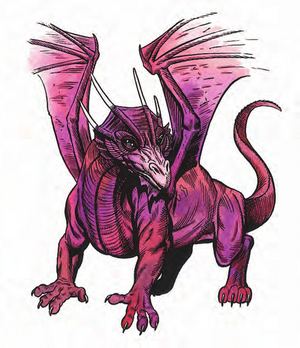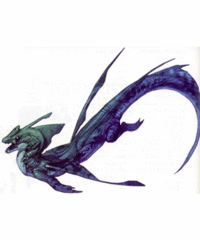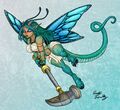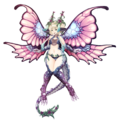Dragonet
The Dragonets are an obscure subspecies of Dragon from early editions of Dungeons & Dragons, characterized by their diminutive stature, generally minimalistic magical abilities, and their willingness to respond to offers of familiarhood by wizards and sorcerers. The name first appeared in Advanced Dungeons & Dragons 2nd edition, when the three "mini-dragons" that had appeared before that point - the Pseudodragon, the Faerie Dragon, and the Firedrake - were lumped together as members of a single party. Sadly, only the pseudodragon and faerie dragon really caught on with gamers, not helped by the fact that half of the dragonets only appeared in Dragon Magazine #272, and whilst those went on to appear in every single edition, the others have remained lost in the mists of AD&D.
Firedrake[edit | edit source]

Despite being one of the original three dragonets, having first appeared in the Fiend Folio, the firedrake (also spelled "fire drake", depending on where you look) never really caught on. This may be because of perceived overlapping with the pseudodragon.
In appearance, these 4ft long, 2ft tall dragonets strongly resemble infant Red Dragons, although they lack the power of their distant cousins. Their hide constantly twitches and quivers, almost imperceptibly, and is somewhat mottled in color, with mauve and burgundy splotches over the red undercolor. Even when on the ground, its wings beat a slow and steady beat, keeping the air flowing around itself and warding off pesky insects. The need for a good airflow is hinted at by the way that shimmers of heat rise from them; firedrakes have pyrophoric blood, containing such a high phosphor content that it is constantly boiling in their veins and bursts into flames when exposed to air. As a result, firedrakes are heavily oxygen dependent, and will suffocate twice as quickly as any normal creature of its size would.
It's actually possible to bottle firedrake blood in a sealed, airtight container. This can be used as a firebomb, as an easy way to light a torch, or even applied to a weapon to temporarily grant it an aura of flames, although doing so can potentially destroy the weapon.
Rather bad-tempered, there is a 50-50 chance when you disturb a firedrake that it will respond by attacking, favoring its vicious bite or spewing gouts of its pyrophoric blood, which it can do five times per day as a 60ft cone. Its blood also makes attacking it with non-bludgeoning weapons quite risky, as each attack has a chance of spattering the assailant with drops of fiery, boiling hot blood. In aerial combat, they prefer to attack from below and behind, and their aura of heat can be disruptive to the efforts of natural flying creatures.
They grow even more vicious when protecting their young; highly familial creatures, firedrakes mate for life and defend their nests and hatchlings at all costs.
A firedrake clutch typically contains 6 to 8 eggs, which are laid within early summer and hatch in 60 days. The timid and somewhat panicky hatchlings can breathe fire almost as soon as they hatch, and will usually blast away at their surroundings several times per day. It takes 60 days from hatching before an infant firedrake learns to fly, and they reach maturity by the spring following their hatching. Once this happens, they leave their family's nest and go flying off to find their own mates and establish their own colonies.
Firedrakes are short-lived compared to true dragons, although they are longest-lived of the dragonets, with a lifespan of 75 to 100 years. Unlike dragons, they don't deliberately hoard, although they have no real compulsion to eject the treasures of any humanoids whom they kill for snooping around in their lair.
Crow's-Nest Dragon[edit | edit source]

Crow's-Nest Dragons are a piscovorous dragonet species native to the coastal regions. Much like sea gulls, they are known for their habit of following ships to feed on the fish that the vessels invariably disturb; their name reflects their tendency to swoop around and perch upon the crow's nest.
Sometimes likened in appearance to pseudodragons, a crow's-nest dragon resembles a small lizard with a long snout full of sharp, conical fangs used to grab slippery prey. They have a very streamlined shape, as their typical hunting behavior entails diving into the water to pursue their piscine meals; they can't breathe water, but can hold their breath for up to 10 minutes. They possess semi-prehensile, monkey-like tails that double their body length to four feet, and long, wide wings that fold close to the body - very reminiscent in shape of a pelican's. This breed of dragonet is very distinctive for its pearl-like iridescent white scales.
Sailors welcome crow's-nest dragons because they consider them a sign of good fortune - indeed, the race has enough magical abilities that a flock's happy presence actually does bestow a minor blessing upon the vessel they travel with, which mechanically is determined by a +15% bonus to the ship's seaworthiness rating. For this reason, sailors prohibit anyone from attacking "their" crow's-nest dragons, as should a member of the flock be killed, the survivors will abandon that vessel and never return.
Like all dragonets, crow's-nest dragons will respond to find familiar spells, and they are amongst the breeds that will sometimes select humanoids as companions - being coastal creatures, naturally, they prefer sailors. Unlike their pseudodragon cousins, whilst they do possess the ability to communicate psionically with a chosen individual within 240 yards, they can only transmit their own vision and their feelings; they have no ability to transmit sound.
Bonded crow's-nest dragons are loyal, but flighty and chaotic - more like Faerie Dragons than Pseudodragons, even sharing the faerie dragons' Chaotic Good alignment. They need much less pampering than pseudodragons, but even when well-treated, are prone to mischievous behavior; their curiosity is insatiable, and sailors assert that their hunger is just as bad.
A crow's-nest dragon typically feeds on fish and cephalopods, being preyed upon in turn by large marine and arboreal predators such as sharks and giant eagles. They defend themselves with their vicious bite, which can rip and tear savagely. When clearly outmatched, they use their breath weapon - a cloud of mystical vapor that duplicates the effects of a Fog Cloud spell cast by a 9th level caster - to cover their escape. They can only use this breath weapon once every day.
Like most dragonets, they mate for life, establishing nests on the tops of rugged sea-cliffs and producing clutches of 3 to 5 offspring at a time.
Crow's-nest dragons are amongst the shortest-lived dragonets, with a natural lifespan of 11 to 20 years.
Geyser Dragon[edit | edit source]

Geyser Dragons are a wingless species of 2ft to 4ft long dragonet whose name comes from their preferred choice of terrain; geothermally active areas where there are an abundance of hot springs and geysers.
Geyser Dragons have a rather piscine appearance, well beyond their silver-flecked, greenish-blue colored scales. Short-legged and with flipper-like webbed feet, these dragonets have long, serpentine bodies. Shark-like fins form crests on their skulls, and a pair of long, slender fins trails out from behind both their shoulders and their hips, as if in imitation of the wings they lack. They move with an eel-like fluidity, and whilst they have no wings, they can still levitate, allowing them "swim" through water and air with great speed and agility. Hot water vapor constantly billows around their bodies as they move; like firedrakes, this dragonet species possesses pyrophoric blood, which in some manner helps insulate them against the superheated waters they live within.
Physically amphibious, possessing lungs and gills, geyser dragons are diurnal in nature, retreating to small cavern-nests to sleep and mate during the night and spending their days playing and hunting. Their affinity for hot springs and geysers sometimes leads them into bath houses and similar structures - and that's when trouble occurs.
Geyser dragons are assuredly the dumbest of the dragonets, suffering a racial case of delusions of dragonhood that gives them an extreme case of overconfidence. As such, geyser dragons will attack even the biggest opponent with savage fury, clawing and biting and spewing gouts of boiling hot water (which they can do thrice per day) with every sincerity in their belief that this can overpower their foe. Although their boiling blood does provide some formidable defenses, burning those who cut or pierce them and rendering them both immune to heat-based attacks and heavily resistant to fire attacks (+4 to saving throws, halve all damage taken), they bite off more than they can chew with startling regularity.
This means that relatively few geyser dragons live out their full 21-32 year lifespan, but they breed rapidly and have few, if any, natural predators (except maybe steam mephits) and so the race survives.
Because they believe themselves mightier than they are, geyser dragons only respond to Find Familiar spells if they believe the wizard or sorcerer calling to them is equally powerful. This means that the typical master of a geyser dragon is boastful and arrogant, although bullying is optional. They have only empathic communication abilities with such bonded allies, although their aggressive natures and boiling water Breath Weapon has its own advantages.
Mole Dragon[edit | edit source]

Mole Dragons are the largest of the dragonet species, growing to some 5ft long and with a thick, stubby tail that can stretch another two-and-a-half feet beyond that. Wingless, they have stout, bulky bodies paired with short, pugnacious snouts, somewhere between a toad and a bulldog. This species of dragonet only has a pair of forelimbs, dragging itself along much like a linnorm; its foreclaws are disproportionately large and powerful, with massive claws that help it to burrow under the ground - this resemblance to a mole's limbs is the source of their moniker.
Mole dragon hides are dark and earthen in color, tending towards a bluish gray. The scales themselves are thick, bumpy ad irregular, reminiscent of a rough stone formation, but glitter like chips of mica. Unusually, as a mole dragon ages, its back develops a coat of gemstones - it's unclear if these form naturally or if mole dragons adhere them to their backs as they find them, but they serve as the closest thing to a hoard that this dragonet has. A mole dragon typically has 1d8 valuable stones per Hit Dice.
These dragonets are truly unique amongst their kind, not just for lacking flight, but for their attitudes. Most other dragonets range from neutral to goodly in alignment, but the mole dragon's dour, sadistic, bitter, vengeful nature makes them the only evil dragonet ever established in AD&D. These grumpy yet vicious dragonets will nurture grudges for years, even decades, and are highly antisocial; mole dragons only mate when their meanderings through the Underdark or cave systems lead to a chance encounter, whereupon the female will lay her eggs in a dead-end cavern and seal them in, leaving the hatchlings to burrow out or die upon birth.
Mole dragons make surprisingly dangerous combatants; their claws, wilst intimidating, are too clumsy to be used for combat, but their bites are vicious, and they can lock onto a victim like a living bear-trap. Though they lack a breath weapon, they have powerful magical abilities. All mole dragons have some innate earth elementalism powers; they can instantly vaporize a significant portion of soil three times per day (treat as a Dig spell affecting a cube of 10ft per HD), summon a lesser elemental of the sandling or sandman varities 1/day, and cast three 1st level cleric spells. Upon reaching 4 hit dice, they can cast Passwall 3/day, Stone Shape at-will, and cast a single 2nd level cleric spell. The most powerful of all mole dragons, those that have reached 5 hit dice or more, have two 2nd level cleric spells per day, can cast Wall of Stone 3/day, and conjure an earth elemental once per week.
All mole dragon cleric spells come from the Spheres of Combat, Divination, Elemental, Guardian and Protection.
Between the fact that they are such nasty little bastards and the fact they can't tolerate coming above-ground for more than a few hours at a time, mole dragons onlyserve as companions or familiars to powerful, malevolent beings willing to live in the Underdark with them. They are most commonly associated with drow, derro, or the rare evil svirfneblin. Humanoid companions who do not share a mole dragon’s love of inflicting pain soon find themselves on the receiving end of the dragonet’s sadism. They are one of the few dragonet species who, when bound as familiars or companions, possess the capacity for full telepathic conversation with their chosen partners, and can speak to them from a range of 300 yards.
One last trait that makes mole dragons absolutely despised by dwarves and any other species with a focus on mining metals is that their diet of choice happens to be precious metals. A mole dragon will seek out a vein of gold or silver and just munch its way from one end to the other, leaving behind nothing but worthless spoil. Whilst its writeup claims that they are often seen alongside duergar, it's hard to imagine these evil dwarves being any more enthused about their gold-munching than surface dwarves are.
Pavilion Dragon[edit | edit source]

Pavilion Dragons are a species of dragonet native to the high canopies of tropical rainforests. Vibrantly colorful, with "gemstone-colored" scales (females are dark blue, like spinels, whilst males are a fiery rainbow of ruby, jacinth and topaz), they have been compared to a cross between a Faerie Dragon and the colorful birds that share their environment: they sport beak-like snouts, large eyes, a rather bird-like body-structure, long tails with rudder-like fins, and long-tipped wings that drape down alongside the tail when folded. They range in size from about 18 inches when hatched to 4ft long at full maturity.
Pavilion dragons are an unaggressive and very intelligent species, with little ambitions beyond living a quiet life and rearing the next generation. Omnivorous, they eat a wide variety of large insects, small birds, eggs, fruits, lizards and even small monkeys. Mating for life, females lay a single egg every spring, with the young remaining with its parents for the first five years of its life; this means pavilion dragons live in family groups of up to seven individuals.
These dragonets are prized as familiars because they are the most even-keeled of their family; fun-loving without being annoying, warm, caring, and very loyal, whilst also being exotic and colorful. Best still, they're not pranksters or attention whores. Able to use full telepathic communication with an ally within 100 yards, their only downside is that they are very attached to their native environments, and usually aren't willing to leave them.
Fighting only to defend themselves, pavilion dragons are unique amongst their family in that they not only possess a Breath Weapon - a sharp screech that stuns all other races within 15 feet, which they can use 3/day - but they also possess potent psionics. Specifically, pavilion dragons have access to the psionic schools of Psychoportation (Teleport, Dimensional Door), Clairsentience (clairaudience, clairvoyance, all-round vision) and Telepathy (attraction, aversion, contact, false sensory input, invisibility, life detection), with a 6th level manifester's skill and 45 PSPs to spend. Whilst hardly suited for direct combat, this makes them very hard to find if they don't want you to.
These dragonets live, on average, 26 to 35 years.
Pseudodragon[edit | edit source]
See its page for full details. But, in summary, pseudodragons are friendly if arrogant miniature dragons of a generally benevolent nature who are very popular as familiars. Personality-wise, they can be summed up as flying, fire-spitting, telepathic cats.
Faerie Dragon[edit | edit source]
See its page for full details. But, in summary, faerie dragons are benevolent, mischievous trickster dragons who can easily be distinguished from other dragonets by their butterfly-like wings, which makes them look kind of like the result of a drunken union between a pseudodragon and a pixie.
"Dragonet"[edit | edit source]
"It is about 3 feet long from its horned nose to the tip of its sinuous tail, and has a wingspan the same size. Its scales are brightly colored, predominantly green but with patches or bands of yellow, black, blue, and fiery red. A feathery crest runs from the top of its head down its spine, ending in a soft tuft at the creature’s tail. Its eyes are large and yellow, and its teeth are needle-sharp"
- – d20 Past
d20 Modern supplement d20 Past includes a monster known simply as "Dragonet". The d20 Modern version of the Sorcerer in the same book gains one automatically as a familiar. The description and picture (where is with a really poorly drawn master) don’t really match any established type of dragonet, nor does its statistics (notably it’s of animal intelligence if not a familiar).
Dragonettes of Midgard=[edit | edit source]
In the campaign setting of Midgard, the concept of dragonets as the smallest, most "animalistic" of the dragon family has been revived. Linked to the greater Drake family, these mini-dragons are called Dragonettes, and so far only two explicit breeds have manifested in the Tome of Beasts series.
Lantern Dragonettes feed on candle wax and can emit glowing light from their torsos. They are believed to be the result of some wizard magically fusing a radiance elemental and a paper drake.
Keyhole Dragonettes are flightless dragonettes that look something like a cross between a dragon, a weasel and a pangolin. They were bred as vermin hunters, but they've also proven to be natural lockpicks, making them popular pets for rogues.
| The Dragons of Dungeons & Dragons | |
|---|---|
| Dragons | Albino Wyrm - Arcane Dragon - Aquatic Dragon - Brine Dragon - Catastrophic Dragon - Cerilian Dragon - Chromatic Dragon - Cloud Dragon - Cobra Dragon - Crimson Dragon - Deep Dragon - Dragonet - Epic Dragon - Faerie Dragon - Fang Dragon - Ferrous Dragon - Gem Dragon - Half-Dragon - Linnorm - Metallic Dragon - Minidragon - Mist Dragon - Moon Dragon - Obsidian Dragon - Oriental Dragon - Planar Dragon - Prismatic Dragon - Pseudodragon - Radiant Dragon - Red Hawk Dragon - Sand Dragon - Sea Wyrm - Shadow Dragon - Song Dragon - Stellar Dragon - Stone Dragon - Sun Dragon - Dragon Turtle |
Monstergirls?[edit | edit source]
Despite what you might think, given they offer a possibility for loli and/or shortstack dragon-girls, dragonets have never received the monstergirls treatment on /tg/. This is no doubt due to the race's obscurity. Then again, there are a handful of faerie dragon-girls out there on the internet, so, who knows?


